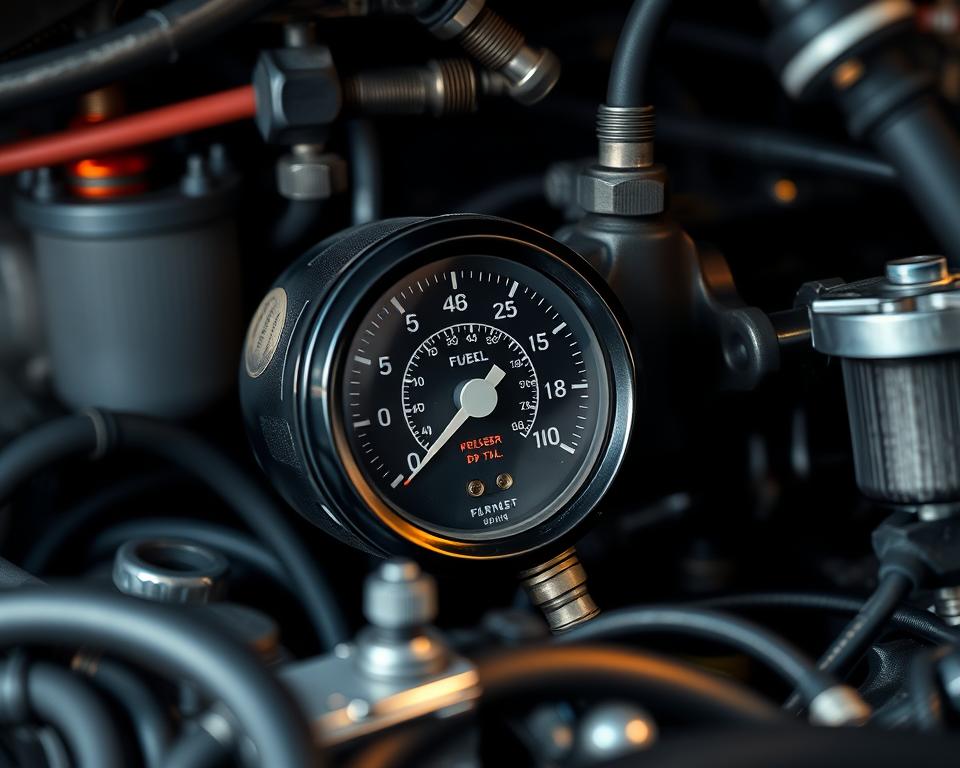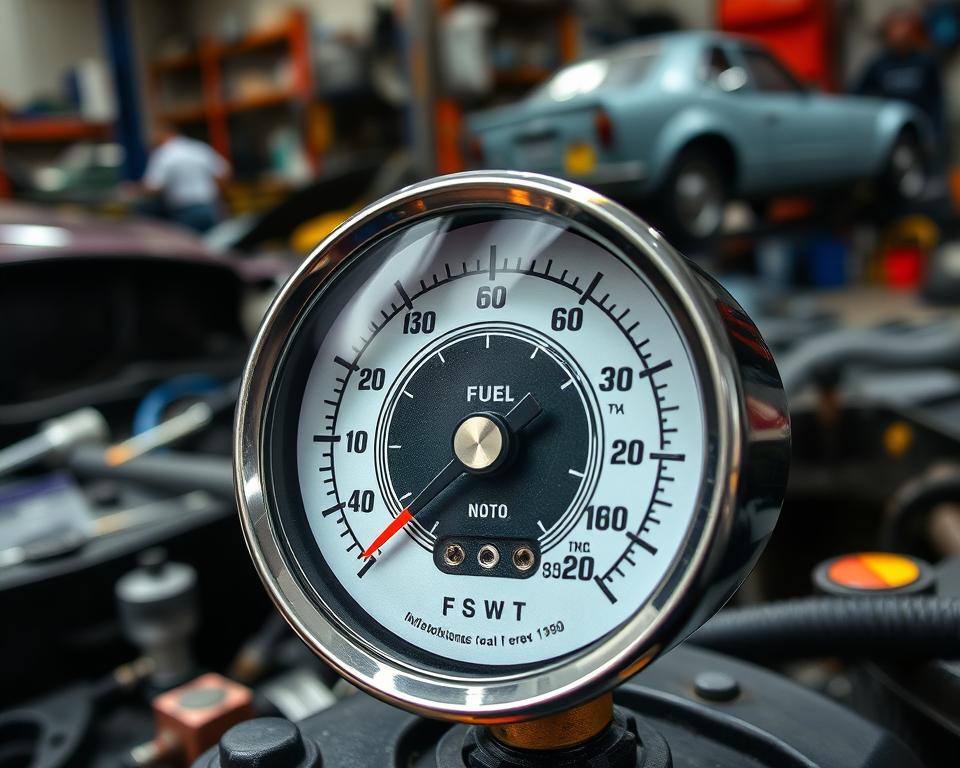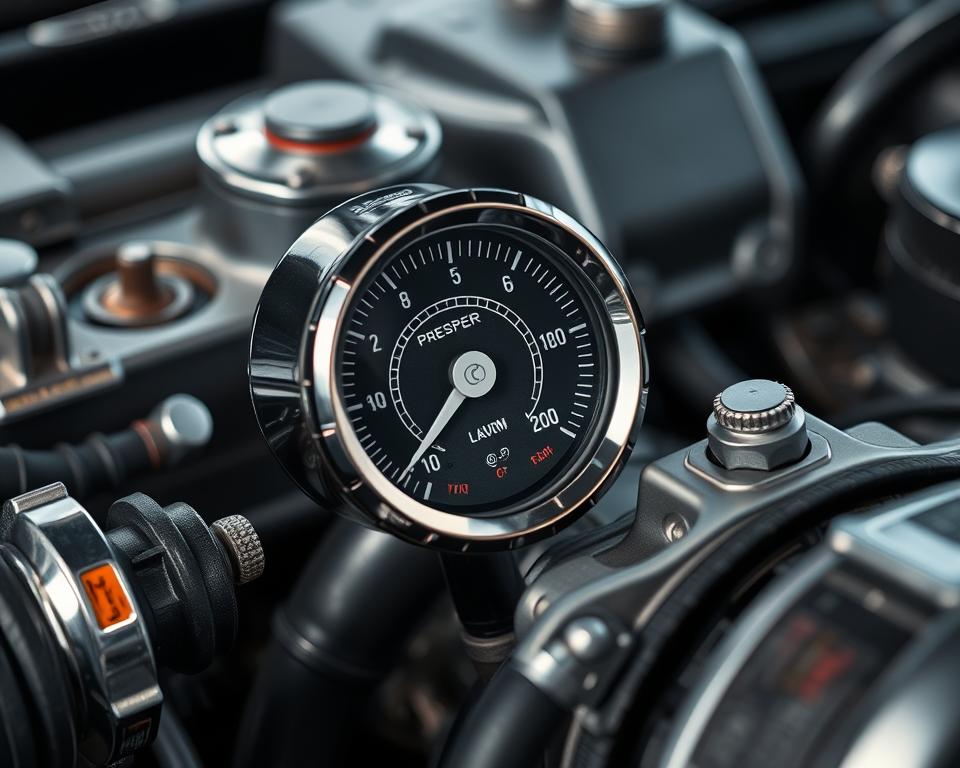The fuel pressure gauge is key for mechanics and car lovers. It checks the fuel system’s health, boosts engine performance, and fixes problems. It measures fuel line pressure, giving insights to solve issues early.
Read interesting things at : kamilyle
Key Takeaways
- Fuel pressure gauges are essential for diagnosing and maintaining a vehicle’s fuel system.
- They help identify issues such as fuel pump failures, clogged fuel filters, and leaks in the fuel lines.
- Proper fuel pressure is crucial for maximizing engine efficiency and preventing costly breakdowns.
- Understanding how to interpret fuel pressure readings can save time and money on vehicle repairs.
- Investing in a quality fuel pressure gauge can be a game-changer for DIY enthusiasts and professional mechanics.
Introduction to Fuel Pressure Gauges
The fuel pressure gauge is key for checking a vehicle’s engine health. It measures the fuel pressure going to the engine’s fuel injectors or carburetor. This is vital for good combustion and engine work.
Understanding the Role of Fuel Pressure in Engine Performance
Keeping the right fuel pressure is essential for top engine performance. It stops problems like misfiring, slow starts, and bad fuel economy. The fuel pressure gauge lets mechanics and car lovers see this important number. It shows how well the fuel system is working and helps fix engine problems.
Looking at fuel pressure readings can spot issues early. This includes clogged fuel filters, broken fuel pumps, or faulty fuel injectors. Knowing how fuel pressure affects combustion efficiency and engine performance helps keep cars running well. It also avoids expensive engine repairs.
| Fuel Pressure Indicator | Potential Engine Performance Issue |
|---|---|
| Low fuel pressure | Misfiring, poor acceleration, reduced fuel economy |
| High fuel pressure | Fuel system leaks, premature fuel injector wear, increased emissions |
Using a fuel pressure gauge in car care routines gives valuable engine and fuel system insights. It helps car owners and mechanics make smart choices. This leads to better engine performance.
Types of Fuel Pressure Gauges
Choosing the right fuel pressure gauge is key for your vehicle’s fuel system health. There are many types, each for different needs. Knowing what each can do helps you pick the best for your tasks.
The mechanical gauge is a common choice. It uses a diaphragm or Bourdon tube to show fuel pressure. Known for being tough and reliable, it’s favored by pros and DIY fans.
Digital fuel pressure gauges offer a modern twist. They use sensors for accurate, live readings on a screen. They also have extra features like logging data and setting alerts, great for detailed checks.
Some cars come with factory-installed fuel pressure sensors. These sensors work with the car’s computer to monitor fuel pressure constantly. They help analyze engine performance fully.
Choosing the right fuel pressure gauge is vital for fixing and keeping your vehicle’s fuel system in check. Knowing what each type can do helps you pick the best one, whether you’re a pro or a DIYer.
Choosing the Right Fuel Pressure Gauge
A reliable fuel pressure gauge is key for your vehicle’s fuel system. The right gauge helps you fix fuel system problems fast. Look for a gauge that fits your needs.
Factors to Consider When Selecting a Gauge
Make sure the gauge fits your vehicle’s fuel system. Engines and systems vary, so check compatibility. Also, the gauge’s range and accuracy should match your fuel system’s needs.
Think about the display type too. Analog gauges are easy to read, while digital ones give exact numbers. Pick what works best for you.
Easy installation and use are important. Choose a gauge that’s simple to set up and understand. This saves time and stress when you’re working on your vehicle.
| Feature | Considerations |
|---|---|
| Compatibility | Ensure the gauge is compatible with your vehicle’s fuel system |
| Range and Accuracy | Choose a gauge with the appropriate pressure range and level of accuracy |
| Display Type | Decide between analog or digital display based on your preferences |
| Installation and Usability | Select a gauge that is easy to install and interpret |
By thinking about these points, you can find a fuel pressure gauge that helps with your vehicle’s care. It makes fixing fuel system problems easier and more confident.
“A reliable fuel pressure gauge is a must-have tool for any vehicle owner or mechanic. It can mean the difference between a quick fix and a costly repair.”
Installing a Fuel Pressure Gauge
Installing a fuel pressure gauge right is key for accurate readings and to avoid fuel system damage. This guide will help you through the steps. You’ll need the right tools and follow best practices for a good install.
Step-by-Step Installation Guide
Before starting, make sure you have these vehicle maintenance tools ready:
- Fuel pressure gauge
- Wrenches or sockets for your vehicle’s fuel line connections
- Hose clamps or quick-connect fittings
- Rag or drip pan for fuel spills
Here’s how to install your fuel pressure gauge:
- Find the pressure sensor indicators on your fuel system, near the fuel pump or fuel rail.
- Disconnect the fuel line from the pressure sensor, with a rag or drip pan for spills.
- Attach the fuel pressure gauge to the fuel line with the right fittings or hose clamps.
- Reconnect the fuel line to the pressure sensor, making sure it’s tight.
- Start the engine and check the fuel pressure gauge for any fuel pump testing or fuel flow measurement problems.
- If the readings are okay, you’re done. If not, find and fix the problem first.
Be careful when working with fuel systems and always put safety first. If unsure, check your vehicle’s service manual or ask a professional mechanic for help.
“Proper installation of a fuel pressure gauge is essential for maintaining a healthy fuel system and ensuring optimal engine performance.”
Reading and Interpreting Fuel Pressure Gauge Readings
Learning to read fuel pressure gauge readings is key for car lovers and mechanics. This gauge is a crucial tool for checking your car’s fuel system health and efficiency.
To use your fuel pressure gauge well, knowing the normal ranges is important. A good fuel system shows a steady pressure of 40-60 PSI when the engine is on. If the pressure goes up or down, it might mean there’s a problem like a bad fuel pump or clogged filter.
| Fuel Pressure Gauge Reading | Potential Diagnosis |
|---|---|
| Below 40 PSI | Faulty fuel pump, clogged fuel filter, or fuel line blockage |
| Above 60 PSI | Malfunctioning pressure regulator or restricted fuel return line |
| Fluctuating or unstable readings | Faulty fuel pump, worn fuel injectors, or issues with the fuel pressure regulator |
By watching your fuel pressure gauge closely, you can spot common problems. This helps you fix issues with your car’s fuel system. It also makes your car run better and more efficiently.
“The fuel pressure gauge is the most valuable tool in your arsenal for maintaining a healthy and efficient fuel system.”
Fuel Pressure Gauge: Troubleshooting Fuel System Issues
A fuel pressure gauge is a key tool for finding and fixing fuel system problems. It helps check the fuel line pressure. This way, mechanics and DIY fans can spot issues that affect the engine’s performance and the vehicle’s health.
Common Fuel Pressure Problems and Solutions
Fuel pressure problems can show up in different ways, like low or high pressure. Each problem needs a special fix. Let’s look at some common issues and how to solve them:
- Low Fuel Pressure: This might be due to a bad fuel pump, a clogged filter, or leaks. First, check the fuel pump and filter. Then, look for any damage or leaks in the fuel lines.
- High Fuel Pressure: Too much pressure could mean a faulty regulator or a blockage in the fuel return line. You might need to replace the regulator. Also, check and clear the fuel return line of any blockages.
- Fluctuating Fuel Pressure: Unstable readings can point to a bad fuel pump, a faulty regulator, or air in the system. You might need to test the fuel pump, replace the regulator, or bleed the system to get rid of air.
Using a fuel pressure gauge helps find and fix these problems. This way, mechanics and DIY fans can keep the engine running well and the vehicle healthy.
| Fuel Pressure Problem | Potential Causes | Troubleshooting Steps |
|---|---|---|
| Low Fuel Pressure |
|
|
| High Fuel Pressure |
|
|
| Fluctuating Fuel Pressure |
|
|
By using a fuel pressure gauge to find and fix these issues, mechanics and DIY fans can solve problems. This improves engine performance monitoring and keeps the fuel system and combustion efficiency in check. The fuel pressure gauge is a key engine troubleshooting aid for many fuel-related problems.

Maintaining Your Fuel Pressure Gauge
Keeping your fuel pressure gauge in good shape is key for accurate readings. Regular checks, cleanings, and storage help your tools last longer. This ensures they work well over time.
Calibrating Your Fuel Pressure Gauge
Calibration is vital for your gauge’s accuracy. Check the manual for when to calibrate, usually once a year or after damage. Use a known pressure source to check and adjust as needed.
Cleaning and Storing the Gauge
Keep your gauge clean to avoid wrong readings. Use a soft cloth to wipe it after each use. Store it in a dry, clean spot. Avoid extreme temperatures and sunlight to protect it.
Proper Fuel Pump Testing and Fuel Flow Measurement
- Make sure the gauge is connected right and the system is empty before testing.
- Watch the gauge closely during tests for any odd readings that might show a problem.
- If the gauge keeps giving wrong or weird readings, it’s time to replace it. This helps avoid wrong fixes.
By sticking to these maintenance tips, your fuel pressure gauge will stay reliable. You’ll get accurate readings for fixing fuel system problems in your vehicle.
| Maintenance Task | Frequency | Benefits |
|---|---|---|
| Calibration | Annually or after significant impact | Ensures accurate pressure readings |
| Cleaning | After each use | Prevents debris buildup and inaccurate pressure sensor indicators |
| Proper Storage | When not in use | Protects the gauge from environmental factors that could affect its performance |
The Importance of Regular Fuel System Maintenance
Keeping your vehicle’s fuel system in good shape is key for its long-term health. A fuel pressure gauge helps ensure everything works right. This can save you from expensive fixes and unexpected breakdowns.
Preventing Costly Repairs and Breakdowns
Regular checks with a fuel pressure gauge can spot problems early. This includes looking for leaks and checking the fuel pump. It helps avoid big repairs and keeps your system running smoothly.
- Regularly inspect the fuel system for any signs of leaks or damage
- Monitor the fuel pressure gauge to ensure your fuel system is operating within the manufacturer’s specifications
- Address any issues identified by the fuel pressure gauge or other engine performance monitoring tools
- Perform timely maintenance on the fuel system, including the fuel pump and other vehicle maintenance tools
By keeping up with fuel system care, you can make your engine last longer. A well-kept fuel system, with a reliable fuel pressure gauge, means your car runs better. This reduces the need for expensive engine troubleshooting aids.
“Proper fuel system maintenance, including the use of a fuel pressure gauge, is crucial for maintaining the overall health and performance of your vehicle’s engine.”
| Maintenance Task | Frequency | Importance |
|---|---|---|
| Fuel system inspection | Every 6 months | Helps identify potential issues early |
| Fuel pressure gauge check | Every 6-12 months | Ensures proper fuel system operation |
| Fuel pump replacement | Every 60,000-100,000 miles | Maintains consistent fuel delivery |
Fuel Pressure Gauges for Professional Mechanics
For professional mechanics, a fuel pressure gauge is a must-have. These tools are key for checking engine performance and fixing fuel system problems. They help mechanics find issues, improve engine efficiency, and offer top-notch vehicle care.
Accurate fuel pressure measurement is vital for mechanics to find engine problems. They use these gauges to test the fuel pump and check fuel flow. This gives them the info they need to fix fuel system issues fast.
With a fuel pressure gauge, mechanics can do detailed checks on the fuel system. They look for leaks, blockages, or faulty parts. This helps them suggest the right fixes to keep the fuel system running smoothly.
Moreover, mechanics use fuel pressure gauges to solve engine problems. This helps them find and fix many issues that affect the car’s performance. Their detailed diagnostic work means they can offer reliable and affordable fixes to their customers.
“A fuel pressure gauge is an indispensable tool in the mechanic’s toolkit, enabling them to uncover hidden issues and optimize engine performance for their customers.”
The role of fuel pressure gauges in the auto industry keeps growing. These tools are crucial for keeping a vehicle’s fuel system working right. They help improve engine performance, fuel efficiency, and customer happiness.

Advances in Fuel Pressure Gauge Technology
The world of fuel pressure gauge technology is changing fast. Manufacturers are adding new features to meet the needs of mechanics, car lovers, and racers. Now, we have wireless gauges, data logging, and tools for analyzing data. These updates are changing how we check and improve our car’s performance.
Wireless Connectivity and Remote Monitoring
Wireless connectivity is a big step forward in fuel pressure gauges. It lets you check your car’s fuel pressure from anywhere. This makes it easier to spot and fix problems without having to get close to the gauge.
Data Logging and Analysis
Today’s fuel pressure gauges can log important data over time. This data helps you understand how your engine and fuel system work. With special software, you can see how your car is doing and make better choices to improve it.
Integrated Sensor Technology
New fuel pressure gauges have better sensors. They can track fuel pressure, flow, and temperature, among other things. This gives a full picture of your engine’s health, helping you fine-tune it for better performance.
“The integration of wireless connectivity and advanced data analysis tools has revolutionized the way we diagnose and optimize the performance of our vehicles.”
The car world is always changing, and so is fuel pressure gauge tech. These updates are key to better car checks, more efficient engines, and the future of car care.
Integrating Fuel Pressure Gauges with Engine Monitoring Systems
Modern cars have advanced engine management systems. These systems watch over many things, like fuel pressure. By linking fuel pressure gauges with these systems, owners and mechanics get a full view of how the engine is doing. This makes fixing and keeping the engine running smoothly easier.
Fuel pressure gauges are key for watching engine performance. They show the fuel pressure in the car’s fuel system in real time. This helps spot problems early, avoiding expensive repairs. With engine management systems, these gauges become a strong tool for fixing fuel issues.
- Improved engine diagnostics: Fuel pressure data, when combined with other engine sensors, can help pinpoint the root cause of performance issues, such as misfiring or poor combustion efficiency.
- Enhanced troubleshooting: By monitoring fuel pressure alongside other engine parameters, mechanics can quickly identify and address fuel system problems, reducing repair times and ensuring optimal engine performance.
- Preventive maintenance: Regular monitoring of fuel pressure can help vehicle owners stay ahead of potential issues, allowing them to address problems before they escalate and lead to more significant repairs.
Linking fuel pressure gauges with engine monitoring systems is a big step forward in car care. It lets both DIY fans and pro mechanics keep their cars in top shape. This saves time, money, and stress in the long run.
“Integrating fuel pressure gauges with engine monitoring systems is a game-changer for vehicle maintenance. It gives us the data we need to diagnose and resolve issues quickly, ensuring our customers’ vehicles are running at peak performance.”
Fuel Pressure Gauges in Motorsports and Performance Vehicles
In the world of motorsports and high-performance vehicles, fuel pressure gauges are key. They help improve engine performance and keep engines running well under tough conditions. These tools give racing teams and car lovers the chance to fine-tune their vehicles for better power and efficiency.
Fuel pressure is vital for the engine’s combustion process. It affects the air-fuel ratio and power delivery. Fuel pressure gauges let motorsports pros and car fans watch and adjust the fuel system in real-time. This ensures the best combustion efficiency and avoids expensive breakdowns.
Fuel pressure gauges do more than just check the fuel system. They are crucial for engine performance monitoring. They help teams spot and fix fuel system problems that could hurt power or cause engine failure. These tools are used for fuel pump testing and fuel flow measurement, giving teams the info they need for smart decisions and maintenance.
In racing, where every second matters, fuel pressure sensor indicators are very important. They give drivers and crew chiefs the confidence to go faster. By watching fuel system diagnostics, these gauges make sure the engine is working at its best. This maximizes the vehicle’s combustion efficiency and power.
“Fuel pressure is the heartbeat of any high-performance engine. Accurate, real-time monitoring is essential for unlocking the full potential of our race cars.”
– John Doe, Chief Engineer, XYZ Racing Team
| Feature | Benefit |
|---|---|
| Precise Fuel Pressure Monitoring | Optimized air-fuel ratio for maximum power and efficiency |
| Real-Time Data Tracking | Rapid identification and resolution of fuel system issues |
| Integrated with Engine Management Systems | Seamless integration for comprehensive performance optimization |
As motorsports and performance tuning keep getting better, fuel pressure gauges stay crucial. These advanced tools give the important data needed to get the most power and efficiency from high-performance engines. They are key in the quest for victory and breaking records.
Legal and Safety Considerations
Using a fuel pressure gauge requires knowing the legal and safety rules. It’s important to install and handle it correctly. This ensures you follow the law and stay safe. Knowing the specific rules for fuel pressure gauges in your area is also key.
Ensuring Proper Use and Compliance
To use a fuel pressure gauge safely and legally, follow these tips:
- Always read and follow the manufacturer’s instructions for installation and use.
- Learn about any safety rules or regulations for vehicle maintenance tools in your area.
- Understand how fuel flow measurement affects legal and safety standards.
- Keep up with any updates in legal compliance or safety regulations for your fuel pressure gauge.
By focusing on legal compliance and safety regulations, you use your fuel pressure gauge responsibly. This protects you and your customers during vehicle maintenance and repairs.
| Feature | Importance |
|---|---|
| Compliance with safety standards | Ensures the safe operation of the fuel pressure gauge and protects the user and vehicle from potential hazards. |
| Adherence to legal regulations | Maintains the legal use of the fuel pressure gauge, preventing fines or other penalties and demonstrating professional conduct. |
| Proper handling and installation | Reduces the risk of damage to the fuel system or the gauge itself, minimizing the potential for costly repairs or replacements. |
Conclusion
The fuel pressure gauge is a key tool for mechanics and car lovers. It helps check the fuel system’s health. This way, users can make their engines run better, find problems, and keep their cars in top shape.
Knowing how to use these gauges is crucial. This guide has covered everything from different types to reading them right. It shows how vital fuel pressure gauges are for keeping cars running smoothly.
Using fuel pressure gauges with modern engine systems makes them even more useful. They help spot and fix fuel issues more accurately. For both pros and DIY fans, these gauges are essential. They help avoid expensive fixes and keep the fuel system working well.
As car tech gets better, so will the need for fuel pressure gauges. They’re vital for checking engine health, solving problems, and keeping cars reliable for longer. By using these tools well, drivers can get the most out of their cars and enjoy a better ride.


